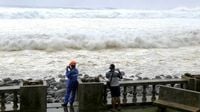As Super Typhoon Ragasa barrelled across the western Pacific in late September 2025, millions across the Philippines, Taiwan, Hong Kong, and southern China braced for one of the most powerful storms in recent memory. With sustained winds topping 143 mph (230 kph) and gusts even higher, Ragasa—locally called Nando in the Philippines—forced mass evacuations, shuttered critical infrastructure, and grounded hundreds of flights, sending shockwaves through the region’s daily life and global transportation networks.
The first major blow landed on September 22, 2025, when Ragasa slammed into Panuitan island off Cagayan province in the northern Philippines. According to the Associated Press, the typhoon’s winds reached a terrifying 134 mph (215 kph), with gusts up to 183 mph (295 kph). The Philippine weather agency immediately warned of “a high risk of life-threatening storm surge with peak heights exceeding 3 meters (nearly 10 feet) within the next 24 hours” for low-lying coastal provinces including Cagayan, Batanes, Ilocos Norte, and Ilocos Sur.
In the face of this threat, Philippine President Ferdinand Marcos Jr. ordered all government offices and schools closed across the capital and 29 northern Luzon provinces. Over 8,200 people sought safety in Cagayan, and 1,220 more fled to emergency shelters in Apayao, a region known for flash floods and landslides. Power outages swept across Calayan island and the mountain province of Apayao, while domestic flights, ferries, and fishing boats were grounded to prevent disaster at sea.
The typhoon’s destructive force was not limited to infrastructure. Reports from the BBC and AP confirmed at least three deaths in the Philippines, with thousands displaced by flooding and landslides. The Office of Civil Defense warned that a separate low-pressure area outside the Philippine Area of Responsibility had a high potential to develop into a tropical depression, compounding the region’s woes.
Ragasa’s westward march next threatened Taiwan, where southern counties Taitung and Pingtung ordered closures in coastal and mountainous areas as well as on Orchid and Green islands. Over 7,000 people were evacuated and six injured, the Central News Agency reported, while more than 8,000 households lost power. Ferry services and flights to outlying islands were suspended, and emergency shelters filled as the storm skirted the island’s southern edge.
By September 23, 2025, Ragasa had entered the South China Sea, maintaining super typhoon intensity as it set its sights on the densely populated Pearl River Delta. China’s National Meteorological Center projected landfall between Shenzhen city and Xuwen county in Guangdong province on September 24. In preparation, the Guangdong provincial government raised its emergency response to the highest level. According to the South China Morning Post, more than 371,000 people were evacuated across the province, and over 10 cities—including the tech giant Shenzhen—ordered the closure of all markets, schools, factories, and transport systems.
China’s disaster response was sweeping. Helicopters, drones, 23 ships, and 38,000 firefighters were placed on standby. The central government dispatched over 60,000 tents, beds, lights, and family kits, according to state-run Xinhua. Shenzhen’s airport and the Hong Kong-Zhuhai-Macao bridge were closed, and by midday on September 23, Shenzhen Bao’an International Airport had already cancelled 210 departing and 319 arriving flights. All buses, taxis, and subways were scheduled to halt by evening, highways were closed, and businesses hurriedly taped windows and secured outdoor objects. Over 18,000 trees were trimmed to reduce hazards from flying debris.
In the heart of Shenzhen, workers at the 1,969-foot-tall Ping An Finance Centre—the world’s fourth-tallest building—reported that the skyscraper was “ready” for the storm. Designed to withstand wind speeds up to 288 kph, the building had previously endured Super Typhoon Mangkhut in 2018, but Ragasa’s approach was a fresh test for the city’s skyline and emergency protocols.
Hong Kong, a global aviation hub, was not spared the chaos. On September 22, the Hong Kong International Airport announced a 36-hour lockdown starting at 6 p.m. local time on September 23, fearing the storm’s direct impact. Major airlines including Emirates, British Airways, Delta, Qantas, Air India, Air New Zealand, Qatar Airways, American Airlines, Cathay Pacific, Japan Airlines, Gulf Air, Bangkok Airways, Ethiopian Airlines, and KLM began cancelling flights preemptively. Emirates alone scrapped eight flights between Dubai and Hong Kong, as well as shuttle flights to Bangkok. Air India announced, “Flight AI314 (Delhi–Hong Kong, 23 Sept) and AI315 (Hong Kong–Delhi, 24 Sept) stand cancelled due to the adverse weather forecast from Typhoon Ragasa in Hong Kong. We regret the inconvenience caused by this situation beyond our control. Passengers are being offered full refunds or a one-time complimentary rescheduling in the same class. Operations to and from Hong Kong will resume once conditions permit safe flying.”
In total, more than 700 flights to and from Hong Kong Airport were expected to be cancelled over the two days following September 23. Hong Kong’s airport authority warned that most flight operations would be affected on September 24, with Cathay Pacific and other local airlines suspending hundreds of flights. The shutdown rippled across the region, with Emirates cancelling flights to Shenzhen and Korean Air warning of possible cancellations to Shenzhen, Macau, and Guangzhou.
Schools in Hong Kong and Macao closed for two days starting September 23, with local authorities urging residents in flood-prone areas to prepare for evacuation. Sandbags and barriers appeared at doors, and many stockpiled food and daily supplies, as reported by AP. In Macao, the government activated its emergency response, expecting Ragasa to pass within 100 kilometers on the morning of September 24.
Meanwhile, cities such as Foshan and Haikou in southern China ordered class cancellations and gradual suspension of businesses and transportation. The BBC highlighted that China had ordered at least 10 cities to shut down schools and businesses, with residents taping up windows and bracing for the storm’s arrival. The Hong Kong Observatory noted that Ragasa was maintaining super typhoon intensity as it approached the Pearl River Estuary, likely impacting millions as it made landfall.
While the typhoon’s impact on the Philippines, Taiwan, and southern China was severe, the region’s advanced preparations, coordinated evacuations, and robust emergency responses helped mitigate what could have been an even greater tragedy. The storm’s full economic and infrastructural toll will take time to assess, but for now, the resilience and adaptability of the affected communities stand as a testament to their experience in facing nature’s fiercest challenges.


